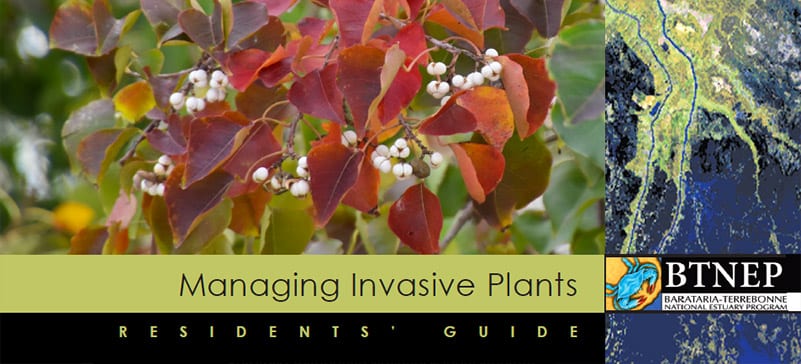THIBODAUX, LA – In order to help local residents identify invasive plants and help control their spread, the Barataria-Terrebonne National Estuary Program (BTNEP) recently published a new residents’ guide titled Managing Invasive Plants. The publication identifies potentially damaging invasive plants and gives residents information on biological control, chemical control with herbicides, and techniques for manual or mechanical control. It also includes pictures of the most prevalent invasive plants in the estuary and suggestions for control. The publication is available at the BTNEP Program Office located on the Nicholls State University Campus in North Babington Hall or can be found on the web at www.BTNEP.org. The publication is free to the public and is available for immediate download.
So how can residents differentiate native plants from invasive ones?
A native plant species is one that occurs naturally in a region. In Louisiana, native plants were here long before European settlers arrived. Thanks to the mild climate, plentiful sunshine, and abundant rainfall, Louisiana has more than its share of beautiful native plants. When you think of native plants in our estuary perhaps you think of bald cypress, live oak, red maple, water lotus, or marshhay cordgrass depending on where you live.
Native plants tend to be better at attracting native wildlife such as birds or butterflies and providing habitat for various local animals to make their homes. Because native plants have evolved to the local climate, including the often unpredictable extremes in temperatures and rainfall, they generally require less maintenance and are more likely to thrive over the long term than most exotic plants.
Exotic plants, although often beautiful, have been introduced from other geographical regions. Freed from the natural system of checks and balances in their indigenous habitat, some exotics flourish and are able to reproduce explosively. They are then considered to be invasive. Invasive plants outcompete native species and may cause damage to the ecology or economy of the region. Plants that come to mind in this category include Chinese tallow, air potato, kudzu, water hyacinth, and salvinia. During this time of year, here in bayou country, our canals may become impassable from a variety of invasive aquatic plants such as the water hyacinth.
Invasive plants may grow unchecked because there are no natural predators. This can negatively impact native species and can cause a decline in our native plants which can have a rippling effect on all the other species that depend on the native organisms.
According to Michael Massimi, BTNEP Environmental Scientist and Invasive Species Coordinator, “Managing invasive weeds is hard to do. Hopefully this publication will be helpful for those folks aiming for good environmental stewardship starting in their own backyards.”
Our native environment provides our sense of place. Our unique and diverse collective culture in south Louisiana is rooted in our connection to local plants and animals. Now, you can do something to help restore the balance so that we can maintain that sense of place that our native plants, like the cypress forests, provide. BTNEP asks that local residents do their part to control invasive plants and to also plant more natives. As surely as we must protect these irreplaceable places from land loss and sea level rise, we must also protect them from the scourge of biological invasion.
The Managing Invasive Plants is part of a resident’s guide series produced by BTNEP. Other publications in the series and also available to the public include Coastal Wetlands Restoration and Attracting Wildlife with Native Plants. Later in 2018, BTNEP will also release its fourth part of the series entitled Homeowners Guide to Improving Water Quality.
For more information, please call the BTNEP office at 985-447-0868.
To view the original press release, click here.


